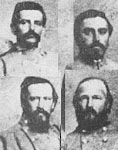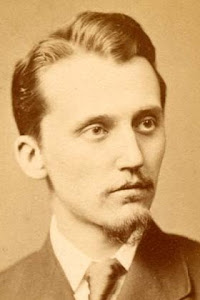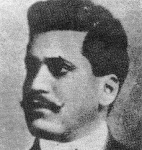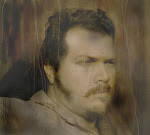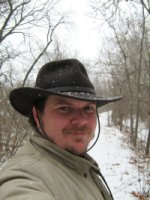Saturday, November 8, 2008
"I Shot Him: James Tooler, ruffian"
Editor, Infernal Herald
James Tooler had quarrel with me over letters I had published about his murderous cousin, Samuel "Blaze" Elliott, three months prior to the display of flying lead betwixt Tooler and me.
Tooler stood inebriated on the boardwalk outside of Slaughter’s Saloon facing the office of our good editor’s newspaper, The Infernal Herald. He called out five times, and every time the same sentence: "Editor! I got words to give you on the account you made of my cousin out’n Agartha!" A full minute had passed between each repetition, enough time for him to take another long draw of rotgut and to fill up on it’s immediate and temporary effect- that effect of being given a sense of (false) courage. And each round of transitionary courage was accompanied by his challenge of "words."
I, being that "editor," was given ample time to prepare myself because of the young ruffian’s lack to action. His courage, no matter how strong by whatever drink, could not survive a walk across the street at me. A stronger man would simply walk across the street, unsheath his Colt and get to work; no words would have been required. But "Jittery" James Tooler was scared. And his fear gave me pause; a man who shoots scared is a dangerous man.
After bridling myself with gun belt and holster, I opened the door of the Infernal office and stood fully visible to Tooler, 10 yards distance from toe to toe. Street traffic had already stopped after Tooler’s second or third repetition of "words," moments earlier.
"I’m here, sir," I said. "What are your words, man?"
Of course, known to the reader and to this writer, Tooler had no words not meant to be delivered by bullet. He stood there as steady as his whiskey-lined belly would allow him. Then came his draw.
He fumbled a bit at the dusty handle of his Colt but soon placed firm grip and jerked the weapon from its resting place. It hung limp in his hand as if the pistol weighed 100 pounds, while he pulled the hammer back with his thumb. A quick shot flew from the barrel and into the mud in the middle of the street, Tooler’s pistol having not been properly leveled before firing.
He cupped the pistol in both hands, more firmly, cocking the hammer with one thumb assisted by the other. Both his hands, this time, brought the gun to bear; Tooler’s aim had the proper latitude, but whiskey made the longitude a more unpredictable affair. The report of his second shot was followed by the shattering of glass of The Infernal’s front window, which many a reader may have noticed to be boarded up these last four days.
Having given a drunk man a fair chance, I drew my Schofield from my belly holster, careful not to rub the front sight against the inside of the holster (a skill I practice for faster draws so as to cut down on time by eliminating any unnecessary friction.) In one motion, I leveled the weapon, pulled back the hammer and took my aim.
In that time, Tooler, took aim for a third shot. Holding his aim, he gained courage enough to take a step toward me so as to better his chances by shortening the distance between us. It was only a pace, though his false courage may have told him he was standing face-to-face with me. Whiskey may be warm in the belly, but it will always lie to a man.
His third shot made a better account of itself splintering the wood not six inches from my left foot. His courage, better, his aim improving, I took no more chances and let loose my shot.
There was no dramatic death as portrayed on the stage or in operetta. There was no clutching of the wound, no slow festering, no final wishes, no eloquent cry of "mother!" Poor Tooler simply fell straight down, crumpled into a pile like an army tent struck, quickly and without ceremony.
This editor, as he always has, paid the fees for coffin and burial.
The window is replaced. The blood is scrubbed. And the people walk that street where another soul has been added to the grim tally.
Friday, November 7, 2008
Update
Monday, August 11, 2008
Deacon "Deadline" Davidson, editor-in-chief, publisher, writer of The Infernal
 There's good reason The Infernal (Hades County's only newspaper) is able to publish its inflammatory rhetoric week after week; It's backed up by Deacon "Deadline" Davidson and his pearl-handled, .45 caliber Schofield pistol. Deadline isn't considered the fastest draw, but he is certainly a crack shot and won't hesitate in a fight with his "critics." Even more insulting to those who have fallen to his words and his bullets, is that Deadline is an easterner. He's only been in Hades County for a year, though, anyone who has survived one year in the county has certainly learned enough to survive in most other places of ill-repute.
There's good reason The Infernal (Hades County's only newspaper) is able to publish its inflammatory rhetoric week after week; It's backed up by Deacon "Deadline" Davidson and his pearl-handled, .45 caliber Schofield pistol. Deadline isn't considered the fastest draw, but he is certainly a crack shot and won't hesitate in a fight with his "critics." Even more insulting to those who have fallen to his words and his bullets, is that Deadline is an easterner. He's only been in Hades County for a year, though, anyone who has survived one year in the county has certainly learned enough to survive in most other places of ill-repute.Deadline doesn't do a lot of talking, instead writing what he wants folks to hear. He does indeed report the news of the county as he can best report it (with limited communication), but readers' favorite section of the Infernal is Deadline's "I shot him" column. Whenever a critic comes to shoot down Deadline for some "Damned lie printed in that Infernal paper," Deadline is sure to win the fight. But Deadline has an excellent memory for details, and he writes about each of his gunfights listing every detail about his enemy, the weather, who any bystanders were and what they were doing, the sounds, the smells, and his own personal musings at the moment of the draw. All of the details are spelled out with the eloquence of Shakespeare and the wit of Twain, and readers can't get enough. Problem is, Deadline only writes those columns after a fight.
Sometimes, when Deadline goes a while without shooting someone, there's no column, and folks get bored with the newspaper. They'll get some poor upstart, small-time criminal and tell him Deadline done gone printed an article about the criminal's mother or sister's "reputation." Hot-headed pistoliers are in constant supply to in Hades County, and so are Deadline's columns as of late.
In Gutshot terms
Deacon "Deadline" Davidson is simply dangerous. He may not get the first shot off, but he is sure to hit once he does shoot.
If you have a newspaper office, Deadline will simply do all his shooting from the front step as long as there is someone in range to shoot at. Inside the newspaper office is kept a rifle, two shotguns and a couple pistols.
Deadline keeps his Schofield on his belt at all times. TN: 6 Specialties: Hard to hit, Reputation, Sure shot (pistol), Quickload, Fanning the gun (he only fan a pistol kept in the office but NOT with his Schofield.)
Sunday, July 13, 2008
Stan O'Tucker
In Gutshot terms: O'Tucker is simply a random element you can add to your games for a little fun. Try him out and see what happens. He'll probably be just an annoyance. If you have a game marshal, have the marshal unleash O'Tucker on the side that is currently winning the game. You could also have him move randomly about the street during the gunfight, only fighting when he comes within one inch of a character.
O'Tucker is armed with a bottle. TN: 8 Specialties: Brawler, Dodge, Tough as nails
Special weapon: Bad Breath. Each time O'Tucker engages a new enemy in melee, he may breathe his horrid drunken breath on his opponent. TN: 4 Defensive TN: 8 Pain: 1D6+2
Note: Inebriation has slowed O'Tucker down. Count each movement step as the next one higher, so, a crawl counts as moving at a walk, a walk as a trot and a trot as a run- O'Tucker cannot move any faster than a trot. AND when he does move at a trot, he must spend his next action either standing still or moving at a crawl as he rests after having moved at such a brisk pace.
Until he attacks someone, no one may target O'Tucker.
Friday, July 4, 2008
Update and flood waters for Gutshot
After discussion over at Hawgleg, however, I am working on (in my head -- that counts) rules for flood waters. For now, I will simply have rooves as the field of play, the water having risen to cover the walls of all the buildings. Anyone brave enough to venture into the waters will have to make some kind if "swimming" roll to avoid being drawn under or away to their doom. More swimming rolls would need to be made if a character is trying to swim a long distance.
Also, I'm trying to think of a basic table for buildings coming off their foundations and being swept along with or without any passengers (who would have to make checks to stay on their feet (perhaps.)
So keep visiting, hopefully you haven't read everything I've posted and have enough to hold you over. If not, don't forget to visit my other blog: http://carmensminiaturepainting.blogspot.com/
I'm pretty sure y'all haven't read all of that one just yet :)
I just need to find time and buy the supplies, but I have not written off building my Newspaper building. Once it is finished, it will have most of its exposure at my painting blog, but I will make stats for an editor, and I will add some fluff for it here.
I think I named the newspaper itself the Infernal. Everything that needs to go into the office (including 1oo printed copies of the paper) are finished; I just need to get crackin' on building the damned thing.
Saturday, May 31, 2008
Slade's Myrmidons
Slade occasionally would come down from the mountains into town for gambling and drinking, and always under an assumed name. He also came down to commit crime of one form or another, and always masked. No one ever saw his face during his crimes, but folks knew it was Slade because he always wore the same hat, a fine silk, New Amsterdam-made top hat.
Slade also had a gang made up of out-of-luck miners, rogues, thieves, hot-headed young men, and the like. Slade called his men his Myrmidons, and he ruled them with fear and violence. Most were sweet-talked into a life of adventure by the smooth-talking Slade, only to learn later the consequence if they tried to leave the gang or otherwise cross Slade. The Myrmidons dared not go against Slade's orders, and followed him without question. In a fight, they spared no violent measure for fear of exposing any unwillingness to their ruthless boss.
In Gutshot terms: Slade is big and tough and a good shot with a pistol. His men will fight just as ruthlessly as Slade, but if they are not in view of Slade, they slack off a bit (as expressed in the special rule below.)
Special rule: When Slade cannot see a Myrmidon, that gang member not only loses his reputation bonus from Slade, the gang member also loses a further -1 modifier to all his rolls as he is simply unwilling to be as mean-spirited as Slade expects him to be. This is ONLY in effect when the myrmidon cannot be seen by Slade.
Slade knows his men slack off at a moment's chance, so he does his best to keep an eye on them" Slade cannot make a move if it puts him out of line of sight of more than half his gang. If more than half his gang are out of sight of Slade, he must use his next action to attempt to locate unseen gang members.
If Slade is killed, the Myrmidons all must roll their TN with a -2 modifier; those who fail will retreat from the area. Those remaining fight with a permanent -3 modifier to all their rolls.
Yep- It makes things difficult for any player playing Slade, but it's something different to try to play out.
Slade: Armed with two pistols and 4 reloads, sawed-off shotgun with 3 reloads, and one helluva big knife. TN: 6 Specialties: Lucky, Hard to hit, True grit, Brawler, Reputation, Sure shot (pistol).
Myrmidons (5-10 gang members adjusted as needed): Usually armed with a pistol or shotgun, and a knife. TN: 7-10 (random). Specialties: (one random from this list) Speedy, Brawler, Fanning the gun, Dodge, Tough as nails, Sure shot (with main weapon.)
Note: Slade and his Myrmidons ar inspired by the personality written about by Mark Twain.
Friday, May 23, 2008
Profile and plan of Saddlerock's Main Street
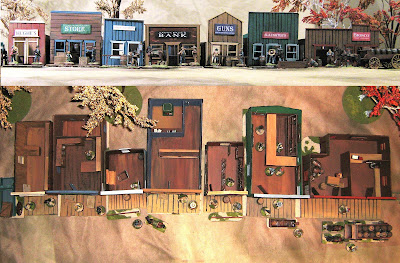
Saturday, May 17, 2008
The Agartha Volunteers

Tuesday, May 13, 2008
Blood Red Roses

The People of hades County
Saturday, May 10, 2008
El Torro aka The Bull aka Alastair Baine
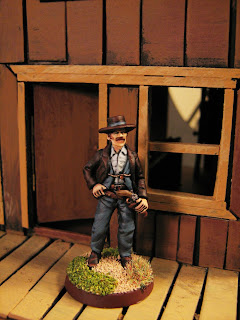
On the New Amsterdam docks, Alastair was accosted by ruffians, robbed, beaten and left with nothing but his pants and shirt; the muggers even took his boots which Alastairhad bought for this trip.
Having nothing to his name, Alastair wandered the streets of New Amsterdam, working when the work could be found, and stealing when the work could not be found. But he knew this life could not be sustained and sought a new solution which he found in the military recruiting office.
With events heating up along the Monterrey Border, Alastair joined up and was quickly transferred to the border with the 12th New Amsterdam Dragoons (under Colonel James Saddlerock, the founder of Hades County.) Alastair remained with the dragoons for 9 years, serving with distinction in the Monterrey wars and the Indian Rebellions of '50 and '53.
Throughout his military years, Alastair was noted for being somewhat bloodthirsty. He had lost many friends in the early months of vicious fighting in the Monterrey war, and was unable to cope with their losses. As his anger for the enemy grew, so did his cruelty.
Across the battle lines, the Monterrey forces took notice of this man from London and gave him the nickname, John Bull, soon shortened to just The Bull or El Torro. El Torro quickly grew out of the shell of the 15-year-old adventure seeker he once was, and into that of a lonesome and cruel man who thought nothing of cutting down women and children. There was no turning back for him.
El Torro continued his cruelty through the Indian Rebellions and as a bushwacker during the War Out East. El Torro had chosen the losing side during the War and was discharged at war's end.
Alastair Baine had known only battle and war for almost 20 years, and now his bloodlust had no outlet. It was a simple decision for him to travel the frontier, stealing, killing, to satisfy his anger toward the world that took his friends, that took his innocence, and that took his boots.
He is well-known in and around Hades County, and everyone stands clear as best they can. Local law, and even large posses are afraid to try to take down El Torro. Only one man had ever dared to take on El Torro and that was Col. Saddlerock, Alastair's former commander.
In one of Hades County's most storied duels, Saddlerock and El Torro had met face to face on the main street of Triple City. The fight started off close in and with knives, but guns were quickly drawn and lead flung. Both men received multiple wounds. The duel ended quickly when the Triple City was attacked by indians (that town being on the border with tribal lands) and every available gun was needed in defense of the town. El Torro slipped away during the fighting.
Though Saddlerock and El Torro recovered from their wounds received during their duel, El Torro was left with a pronounced limp in his left leg having been shot in the thigh. His hatred for Saddlerock simmers and boils, but El Torro knows Saddlerock is his match. So, instead, he takes out his anger on Saddlerock's legacy, that of the land and people of Hades County.
In Gutshot terms: El Torro is as bad as they get in Hades County. He is an excellent shot with pistol and rifle. He is a born rider having ridden in 20 years of warfare. And he is a vicious and strong brawler and knife fighter having fought members of just about every indian tribe this side of the Muddy River.
El Torro is armed with two pistols (two reloads each), a repeater rifle, and a large bowie knife (some have swore it was a shortsword.)
TN: 4 Specialties: Sureshot rifle, brawler, tough as nails, true grit, reputation and horsemanship. Note: Having gained a limp from the duel with Col. Saddlerock, El Torro's speeds are all reduced by one increment (so a crawl is considered a walk, a walk a trot, and a trot as a run) for purposes of deciding modifiers. El Torro may not move faster than 8 inches.
The Ralph Benslow gang
Ralph never adjusted to the move and quickly took up a life of petty crime. Along the way, he taught himself to shoot. He also learned to shoot with two guns and seemed to have quite an aptitude for it. Backed up by the power of the gun, Ralph's petty crimes quickly advanced to robbings and killings. Ralph had few friends, but those he did have formed the core of his gang: Mack Roberts, of Agartha, and twins Richard and Robert Sitzman, trail nomads who are thought to have originated from Omaha. These are the original Ralph Benslow Four.
During the gang's history, gang members would come and go. The gang's numbers counted sometimes up to 20 or 30 men, while other times it consisted of 5 or 6. All the while, the core group remained. No matter how many members were in the gang at any particular time, it was always known as the "Four." It seamed a minor point of information. But many an unweary bounty hunter or glory seeker met their demise having underestimated the Benslow gang's true numbers.
In Gutshot terms: The Ralph Benslow Four is pretty straightforward; It's core is made up of some fine gunmen, whereas any added hangers-on are simply cowpunchers, petty thieves, small-time thugs or any other assortment of minor rabble. The core members all have pairs of weapons: Ralph and Mack, each with a pair of pistols, Richard and Robert, each with a pair of shotguns.
Ralph Benslow: Armed with a pair of well-taken care of pistols with five reloads total. When using these pistols, Ralph (or anyone lucky enough to come into posession of the pistols) counts as having the Reliable specialty- but only for these pistols. (Except if the player already has the Reliable specialty.) TN: 6 Specialties: 2-gun shootist, Sureshot pistols, Reliable (with the pistols).
Mack Roberts: Two pistols with four total reloads, and two knives. Mack Roberts will brandish both pistols, but he does not have the 2-gun shootist specialty. He may, however, alternate fire with the pistols, firing one per action. TN: 7 Specialties: Lucky, Tough as nails.
Richard and Robert Sitzman have identical stats: Each have two shotguns and bandoliers with 25 extra shells. TN: 7 Specialties (both twins): Dodge, Quickload.
Other gang members: Before each battle, the gang increases in number (in addition to the core members) by 1D6+1. These extra members will have a TN of 9 or 10 (randomly determined.)
Thursday, May 8, 2008
The Ralph Benslow Four
Arriving at the north end of Main Street, they found only two (friendly) buckaroos hiding behind a wagon, and the sheriff lying wounded in the middle of the street a hundred feet away.
Otherwise, there were no sounds except the wind. Two horses were hitched to a freight wagon in front of the bank, and a lone riderless horse was tied to a hitchin post toward the middle of town near where the sheriff lay.
"Ya best git yer heads down, fellas!" one of the buckaroos yelled in a whisper. "Them Benslow boys is all over town."
The boys took a moment to assess the situation and decided to split up to take on the gang members one-on-one. Dan went into the stage station, Owen took the bank, and Seamus sneaked behind the short row of buildings to make an attempt to pull the wounded sheriff into cover.
It took Dan all of one minute to discover the gatling gun stored in the freight room of the stage station. Dan had fired a gatling once during the the last Indian war; he called the buckaroos to give him a hand. The remainder of the day was "fun" for Dan.
Meanwhile, Owen saw three or four men inside the bank, but couldn't get an accurate count, nor a division of who was bad and who was good; before he could figure things out, a shot rang out and took his hat off. Owen, for most of the battle, would play a dangerous game of point blank shooting; he, in the cover of the outside corner of the bank, and "they," in a window and behind an open door, both not more than 6 feet from the bank's corner. Dan took a peek through the cracked doors of the freight station across the street. He knew Owen could handle himself. He also pitied the two gang members who plucked away with their shotguns.
"Poor, fools. Heheheheh." Dan certainly was happy with his knowledge of "thundering" away with the gatling.
Down the street, Seamus managed to carry the sheriff to safety, but was sniped at from a couple undetermined locations. Soon enough, a couple of the gang came out of the gun store and the saloon at the south end of the street. After a few shots, Seamus took cover in the barbershop.
Back at the bank, another gang member rounded the opposite side of the bank from Owen and threw some bags into the wagon. He climbed into the driver's seat and took a shot at Owen. Owen was hurting; he had already taken hits from the first two black hats and was close to passing out.
Seamus also had taken a couple hits. The Benslow gang was unleashed with barely a scratch. The boys was feelin' mighty pinched. They were wonderin' if God wanted them to lose. Well, not Dan.
Let us take a moment to take notice of something: The name of the gang is the Ralph Benslow Four. The boys discovered seven gang members. "What gives?" Well, that was just the name of the gang. They needed some help, so they hired on a few more hands; they were just too lazy to change the name of the gang.
Back to the battle!
Ralph Benslow himself emerged from the saloon, both guns blazing at Seamus, and Seamus returning fire in ernest. Ralph's intension was to get on his horse and lead the rest of the boys, the wagon and their loot out of the north side of town. The skirmish was short and bloody, each man taking his fair share of hits.
Ralph finally made it to his horse and got one foot in the stirrup, but would not rise to the saddle; Seamus had emerged from his little barbershop fort and shot Ralph down most indignantly.
During this skirmish, one of the gang members had ran past Seamus. The man had dropped his gun and was running for his life to the wagon in hopes of escape with the rest of the gang.
The remainder of the gang was in and around the wagon all exchanging short-range shots with Owen who had barely moved 5 feet during the whole affair. It was best he stay in his own 5 feet, too. Like a man standing on a cliff overlooking Hades, one false step would land him in an eternity of hellfire.
Seamus greatly allieved Owen's predicament by providing a crossfire from down the street.
With the gang all mounted in the wagon, guns blazing, the driver released the brake and started to ride off.
Then the doors of the freight station opened. Dan smiled and hollered a warning to Owen: "GIT YER HEAD THE HELL DOWN IF YOU KNOW WHAT'S GOOD FER YE- HERE COME'S THE THUNDER!!"
At that short range, the Ralph Benslow Four stood no chance.
The townsfolk came out of their hiding places. A reward was given to the boys, and a round of free drinks was poured for the buckaroos.
Seamus, Owen and Dan each got a new horse out of the whole deal. Dan was sore that he could not keep the gatling; it belonged to the Federal Dragoon patrol which returned to town later in the evening. The Ralph Benslow Four was buried on a small hill under a tombstone that read:
"They who lie here are the Ralph Benslow Four,
They had seven guns but Dan had more."
The sheriff lived.
